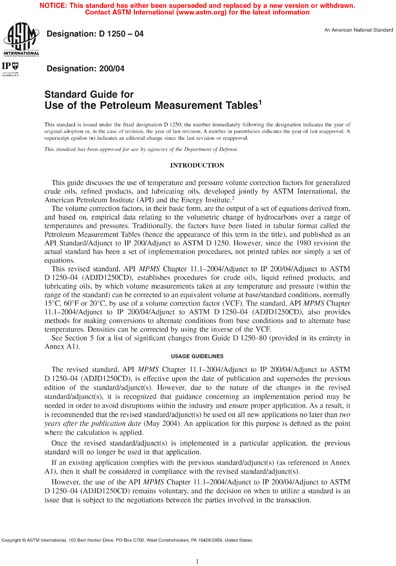Historical
ASTM D1250-04
Standard Guide for Use of the Petroleum Measurement Tables
1.1 The API MPMS Chapter 11.1-2004/Adjunct to IP 200/04/Adjunct to ASTM D 1250-04 (ADJD1250CD) for temperature and pressure volume correction factors for generalized crude oils, refined products, and lubricating oils, provides the algorithm and implementation procedure for the correction of temperature and pressure effects on density and volume of liquid hydrocarbons. Natural gas liquids (NGLs) and liquefied petroleum gases (LPGs) are excluded from consideration. The combination of density and volume correction factors for both temperature and pressure is collectively referred to in the standard/adjunct(s) as a Volume Correction Factor (VCF). The temperature portion of this correction is termed the Correction for the effect of Temperature on Liquid (CTL). The pressure portion is termed the Correction for the effect of Pressure on Liquid (CPL).
1.2 Including the pressure correction in API MPMS Chapter 11.1-2004/Adjunct to IP 200/04/Adjunct to ASTM D 1250-04 (ADJD1250CD) represents an important change from the "temperature only" correction factors given in the 1980 Petroleum Measurement Tables. However, if the pressure is one atmosphere (the standard pressure) then there is no pressure correction and the standard/adjunct(s) will give VCF values consistent with the 1980 Petroleum Measurement Tables.
1.3 API MPMS Chapter 11.1-2004/Adjunct to IP 200/04/Adjunct to ASTM D 1250-04 (ADJD1250CD) covers general procedures for the conversion of input data to a form that is consistent with the computation procedures used to generate VCF values. Two sets of procedures are included for computing volume correction factor: one set for data expressed in customary units (temperature in F, pressure in psig); the other for the metric system of units (temperature in C, pressure in kPa or bar). In contrast to the 1980 Petroleum Measurement Tables, the metric procedures require the procedure for customary units be used first to compute density at 60F. This value is then further corrected to give the metric output. The metric procedures now incorporate the base temperature of 20C in addition to 15C.
1.4 The procedures recognize three distinct commodity groups: crude oil, refined products, and lubricating oils. A procedure is also provided for determining volume correction for special applications where the generalized commodity groups' parameters may not adequately represent the thermal expansion properties of the liquid and a precise thermal expansion coefficient has been determined by experiment.
Content Provider
ASTM International [astm]






